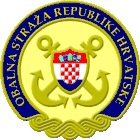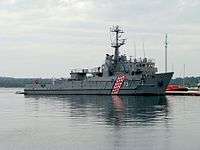Croatian Coast Guard
The Croatian Coast Guard (Croatian: Obalna straža Republike Hrvatske) is a division of the Croatian Navy responsible for protecting the interests of the Republic of Croatia at sea. The Croatian Navy is composed of classical naval forces structured into a flotilla and the Coast Guard that solely consists of ships with peacetime duties, e.g. protection of ecology, fishing, control of tankers, ballast waters, combat against terrorism, trafficking of people, narcotics, and similar.[2]
| Croatian Coast Guard Obalna straža Republike Hrvatske | |
|---|---|
 Emblem of Croatian Coast Guard | |
 Racing stripe | |
 Coast Guard Ensign | |
| Agency overview | |
| Formed | 2007 |
| Jurisdictional structure | |
| Operations jurisdiction | Croatia |
| Constituting instrument |
|
| Specialist jurisdiction |
|
| Operational structure | |
| Parent agency | Croatian Navy |
| Facilities | |
| Planes |
|
| Notables | |
| People |
|
| Anniversary |
|
History and Mission
On September 13, 2007, the Croatian Parliament passed a bill establishing the Croatian Coast Guard. The Coast Guard's mission is protect sovereign rights and carry out Croatia's jurisdiction in the Ecological and Fisheries Protection Zone, the continental shelf and the high seas. The Coast Guard will also monitor vessels sailing in the Croatian territorial waters. If vessels are caught violating Croatian or international regulations and disregard warnings by the Coast Guard, Coast Guard ships and airplanes are authorized to pursue them and if necessary open fire, while taking care not to jeopardize the lives of the vessel's crew.
Under the law, the commander of the Coast Guard is a Navy officer who is appointed and relieved of duty by the President of the Republic at the government's proposal.[3]
Organizational structure and vessels
Ships of Croatian Navy under the Command of Coast Guard:
- Coast Guard Command
- 1st Division - Split
- OB-01 Novigrad
- OB-02 Šolta
- OB-31 Omiš
- BŠ-72 Andrija Mohorovičić
- SB-73 Faust Vrančić
- PT-71 Meduza
- Tug LR-71
- 2nd Division - Pula
- OB-03 Cavtat
- OB-04 Hrvatska Kostajnica
- Tug LR-73
Croatian part of Adriatic Sea is also controlled by Croatian Police - Maritime department and Harbormasters’ offices (Lučka kapetanija) whose ships are marked similar to Navy ships.
Besides the warships, the Coast Guard has at its disposal two Pilatus PC-9 aircraft and four Mil Mi-8 helicopters of the Croatian Air Force and Defense.
Current fleet status
The cornerstone of the Coast Guard forces are four former Yugoslav Mirna class patrol boats (OB-01 through 04). They have recently been upgraded with new radars and their stern anti-aircraft guns have been replaced with hoists for a semi-rigid inflatable. These are to be augmented and eventually replaced by an entirely new class. Coast Guard possess one new offshore patrol ship OOB-31 Omiš built in Brodosplit which is lead ship in future class.
Future developments
| External images | |
|---|---|
Construction of the first out of the projected 5 shore patrol vessels (additional 10 were planned for later) was scheduled to start in 2007, however due to the onset of the economic crisis the international tender for the construction of 1 + 4 vessels was published only on April 24, 2013. The tender calls for the acquisition of a total of 5 inshore patrol ships (Croatian obalni ophodni brod, OOB) which are to be 43.5 meters long, with a displacement of roughly 220 tons and a maximum sustained speed of at least 28 knots. They are to be armed with a 30 mm Remote weapon station as their main armament along with two 12,7 mm heavy machine guns and 4 MANPADS launchers. The tender was completed in May 2014 and the construction of the first ship was to start in the last quarter of the same year. As projected, the first vessel was to enter service in 2015, the second one in 2016, the third and the fourth in 2017 and the last one in 2018. Units are projected to cost around 10 million euros respectively (375 million kuna for first 5 ships).[5][6] However, the first ship (prototype) was laid down in September 2015[7] and is expected to be launched and commissioned in the beginning of 2017.[8] In a TV interview in October 2016, Croatian Navy commander, rear-admiral Stipanović, stated that Croatian Coast Guard would eventually need additional 10 inshore patrol vessels (on top of five planned and ordered) to be fully operational.[9]
Gallery
- Croatian Navy's patrol boats OB-03 Cavtat and OB-04 Hrvatska Kostajnica
 BS-73 Faust Vrančić
BS-73 Faust Vrančić OB-01 Novigrad with old pennant number and racing stripes
OB-01 Novigrad with old pennant number and racing stripes Tug LR-73
Tug LR-73 A boat of the Search and Rescue Services in Trogir, Spring 2014
A boat of the Search and Rescue Services in Trogir, Spring 2014 New racing stripes on Croatian Navy's BS-73 Faust Vrančić
New racing stripes on Croatian Navy's BS-73 Faust Vrančić
References
- "Zakon o Obalnoj straži Republike Hrvatske" [Coast Guard Act of the Republic of Croatia]. Act No. 125 of 28 December 2019.
- "U obrani interesa od Savudrije do Molunta". Archived from the original on 2008-03-14. Retrieved 2009-01-29.
- "Archived copy". Archived from the original on 2012-02-13. Retrieved 2008-08-18.CS1 maint: archived copy as title (link)
- Brodosplit Shipyard
- "Pokrenuta nabava obalnih ophodnih brodova (OOB) - 1+4". Archived from the original on 14 December 2014. Retrieved 14 December 2014.
- "Ophodni brodovi: prototip za godinu dana, a ostali za deset miseci > Slobodna Dalmacija > Split". Retrieved 14 December 2014.
- D. Vlahović: "Položena kobilica obalnog ophodnog broda", Hrvatski vojnik, 18.09.2015
- "OOB u izgradnji: pogled iz Brodosplita", obris.org, 06/08/2016
- Tabak, Igor. "kontraadmiral Stipanović za HTV o budućnosti HRM-a", obris.org, 14/10/2016
External links
- CCG live fire exercise "Prstac 16", 2016. YouTube.